Femme. Whispered. Purred. Growled. Madonna’s “Express Yourself” may play on small, overly trebly speakers as we apply our makeup. Like… a lot of makeup. Immaculate and preciously, precisely placed flecks of glitter. Swath of eyeshadow gradient. And then dance the applied adornment into a whole new iteration of a look… eyeliner smeared in careless touches and mascara moving in drips down cheeks being pulled towards my throat on tracks of sweat. I am long, painted nails twisting up nervous coiled phone cords or tapping rhythmically on pale pink porcelain. I live in the folds of full-skirted 80’s prom dresses. I am made of heels so sharp they could cut glass. I am a great many necklaces worn all at once.
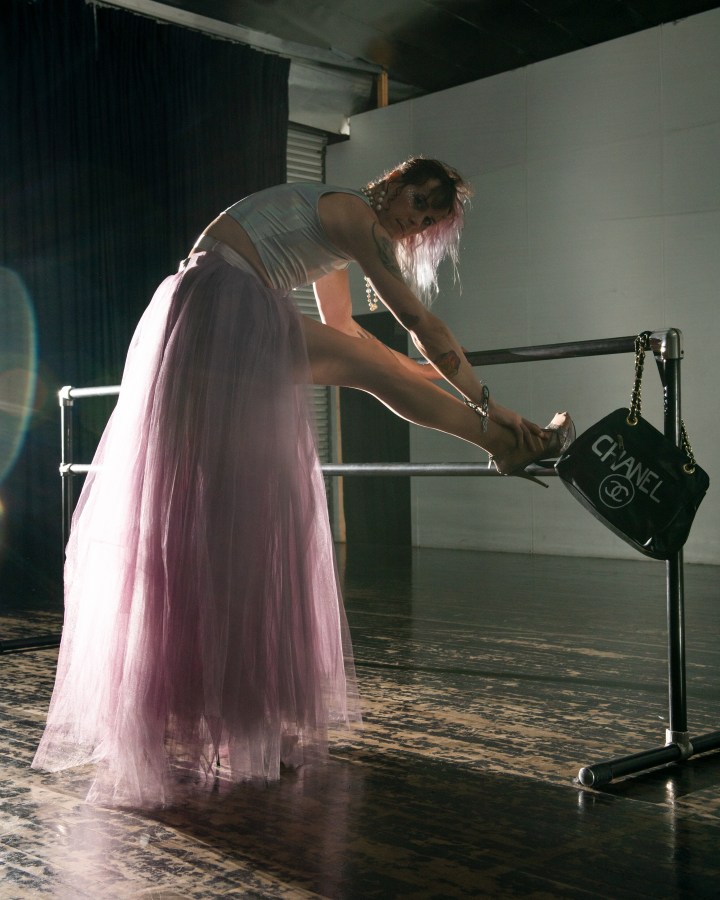
But these are constructs. The structure and shape of my iridescent ankle boot with six inch heels is only feminine because of cultural placement. Bury my shoeboxes in the earth for a few centuries and whoever uncovers them, the enduring synthetic materials, may not even know the meaning of the term “women’s wear.” With any hope their understanding of gender will have transformed into something liberatory and expansive and bear not even a vestige of our binary and bioessentialist categorizations. I imagine a variant of Ariel in her cave of treasures — such a material “girl” — projecting associations on found objects and combing her hair with a fork.
Yet even my Little Mermaid reference point is telling of some refraction of my gender identity, in how I’ve assembled the correlative hope for shared reality. I believe that some part of me and my femmeness is inherent to my corporeal biological form and my spiritual existence; however so much of how we construct and understand our gender(s) is informed by cultural placement. What occurs so often then when we try to anchor or define the inherent and or internal quality of our gender with external elements is this ouroboros (mine looks like an elongated tube of lipstick, melted/melting) where the evidences we find or bring forth are cultural in origin and therefore have no inherent quality to define or codify our gender(s). We are just chasing our tails. Infinite regress. For this reason the distinction between authentic and performative gender is difficult to demonstrate or articulate. This is true for people of all genders including cisgender bodies.
There are so many things I may reach for to explain how I know I am a femme or an intersex non-binary woman but these words and concepts themselves are devised and constructed. My intersex body demonstrates itself physiologically and externally, even outside of any cultural placement. My transness may be more or less visually obvious depending on your perception. Recent endocrinological studies have demonstrated evidence that seem to indicate trans specific brain chemistry, inherent physiological and chemical demonstrations of transness that have discernible corollaries to our genders, but even then these evidences are mostly approached from a binary framework and one of a specific cultural construction. And most of this evidential framing of trans and non-binary existence, the desire for some biological “proof” of our actuality, is fodder for transphobes and all too often devised from a US/Eurocentric scientific/medical origin which has hxstorically been used to transphobic ends. This is also a system that constructed and employed eugenics as a dominant practice. We do not need to justify our existence, in ANY capacity, and certainly not within a system that has been used to harm us. There is widespread evidence of transness and non-binary existence across a great many human cultures and many of them have vast hxstorical depth.
This essay is mostly about how I come to know and define myself as a “femme” and how I practice embodiment of it within my culture. Although femininity has some relationship with the constructs of woman and girl, through frequency of use and cultural assignment, they are not synonymous or directly connected by any means. There are many feminine men and many femmes that are not girls or women. But undeniably these connections do exist as does the proximity of femme to the construct of femininity. If femme as a chosen gender identity, is connected to femininity, as we define it more broadly in mainstream culture, then where do I anchor femmeness and how do I understand it? There are so many aspects of what seem to have an innate feminine quality that I relate to and identify with but of course this too is frequently an illusion and a machination of patriarchal, Eurocentric, white supremacy.
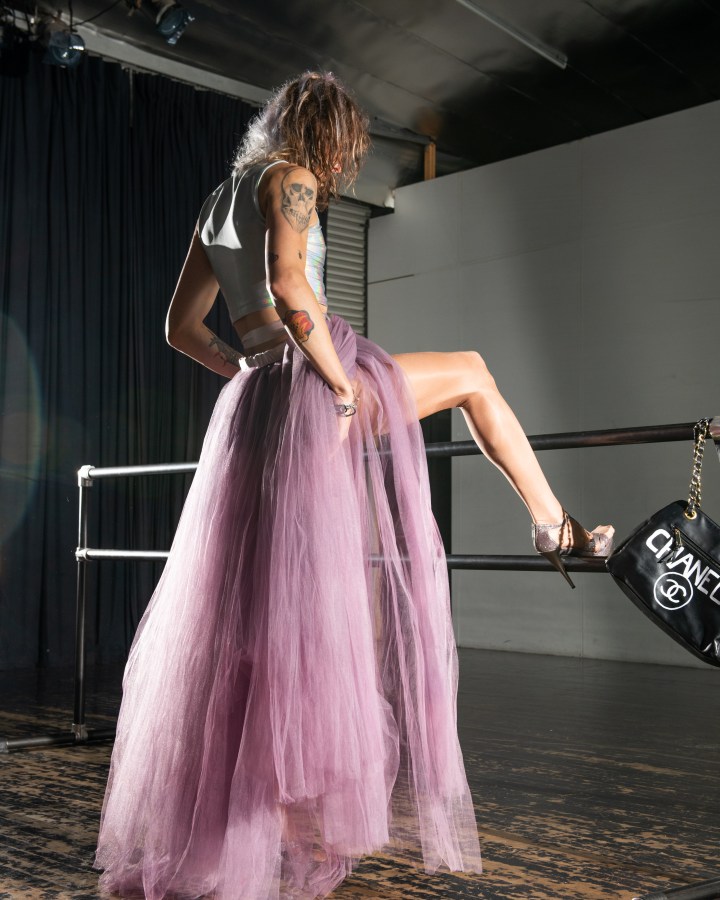
Pink can serve as an excellent example of this concept. Pink, a shade as much as a color, is something with such seemingly chasmic gendered associations in the US with “girls” and “girly” qualities and yet it only came to have such an association just prior to World War I. And the use of pastel pink and blue color assignment for babies arrived here in the mid-19th century (Feinberg, Transgender Warriors, 1997). Both supremely fresh in the spectrum of recorded human record. And yet it at times seems as if this has been the way for all of time. So is the terrible and destructive power of normalization processes, rendered invisible to so many eyes, so that they exist as the immutably “natural order” and portrayed to have always been so. But as far as this seemingly ubiquitous gendered color scheme for some time prior to World War I there existed an opposite gender color assignment/association where pink was used predominantly for “boys” and blue was used for “girls.” And this is a US/European culturally specific coding at that. I offer this to convey, at least for myself, so many components I employ to relate to my inherent gender qualities utilize external elements that often are cultural constructs with no innate qualities of positioning — and rather new cultural constructs at that.
Gender in its infinite and expansive nature, is still tied to some cultural placement. Words themselves are a construct of flawed human manufacture. And when we are trying to extricate something that exists predominantly in the internal, we will always fall short of a perfect extraction and correlation, to some degree, when we speak or write them out because these tools are so limited in relating something that feels so magically ethereal and intangible inside of me. Just as there is so much arrogance in the microscope… that when we gaze through it’s optics we believe we are moving closer to objective truth.
There are times I find solace in my feminine constructions. Maybe less and less as I deepen my understanding of the gender binary but they remain. There is an affirmation that transcends the oppressive walls of category. My early kitten memories are strikingly retained of sitting in front of a TV and staring, starry eyed, at JEM. I’m not sure where I fell in the run of Jem and Holograms from 1985-1988 but wherever I fell in that timeline for the show, I fell in love. So much so that here we are decades later and I’m still modeling aspects of my identity on Jem, Jerrica, and Kimber. Fronting a pop band, albeit with our own politics, I will clad myself in pink plastic and lavender glittered skirts, shimmering neon stripes painted across my face and enough blush to read from the back of any room. Jem was a guiding star for my young femme spirit. Pink hair, eccentric makeup, and THE OUTFITS. She was powerful, intelligent, and resourceful. And she literally transmutated at least once an episode. And she was me. Or some idealized representation we look to in trying to form ourselves. Mirror neurons and cathode rays. It wasn’t until recently I unpacked my subconsciously projected trans narrative of the show in the capacity of Jerrica to literally transform herself at will and experience recurring transitions/makeovers/metamorphoses in each episode, but that is a theoretical distillation for another time. I was very little and that show left a very big mark.
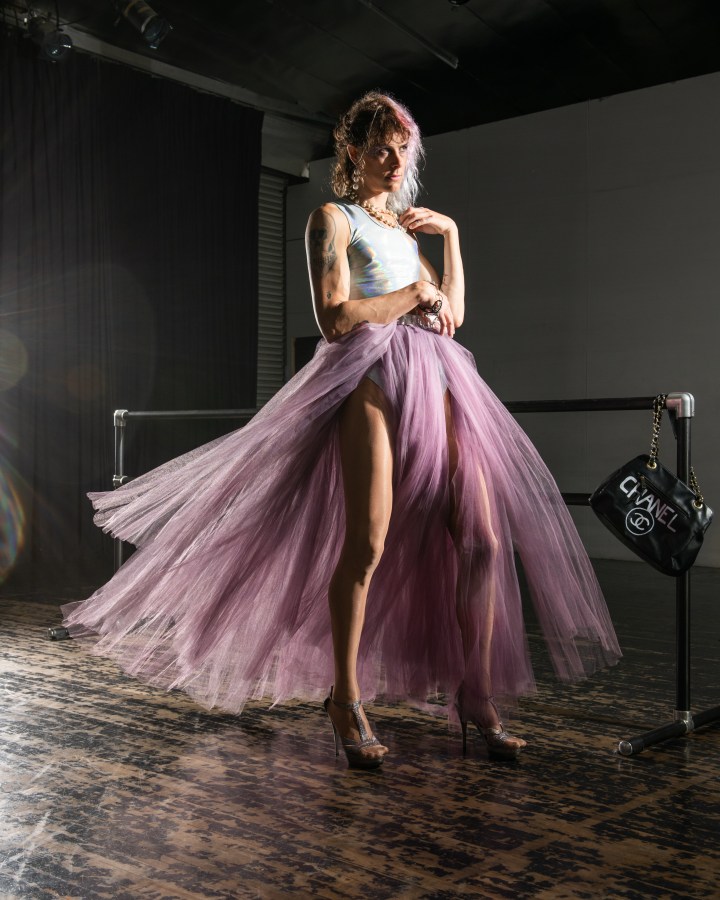
Make-up is another interesting notion as it pertains to gender expression. Make-up has so many varied associations to different gender identities in a cross cultural framework and only some of them have associations to “femininity.” For many other cultures, make-up has strong associations to the construct of being a “man” and “masculinity.” Just as “pink” is the modern Eurocentric association of the feminine, make-up is more of a modern development. There are large periods of time when it was normalized for cis men to wear makeup, and it wasn’t until the mid 1800s that this shifted to the other binary position.
My own experience with makeup is as a potion, and only a small sliver of how I come to frame myself as a “femme,” employing praxis from a queer perspective existing outside of the cis male gaze. I put on makeup often for my own enjoyment and connection, playing with colors and shapes and luminosity. At times it makes me feel beautiful. But my conception of beauty is so deeply ingrained and informed by culture that no doubt, even in moments of doing it for myself, the reasons for it eliciting joy cannot be completely extracted from those same oppressive beauty standards. And there are times I do end up wearing makeup for others. There are times I need to use it as armor to defend myself through assimilation and “passing.” To avoid misgendering and a whole range of harm and violence directed at transfeminine bodies and our existence. There are days I really don’t want to put on makeup and feel like I have to in order to reduce the chance of harm. In those days I am doing it for men. To increase my chances of safety in a transphobic culture of their dominion.
In tracing my own hxstory I find some comfort in knowing I just wanted to play dress up and make-believe in tiny plastic pastel kitchens. I was not even an adolescent, obsessively drawn to these celebrity feminine entities and games designed for “little girls” — perhaps prior or at the very least contemporaneous with my developing understanding of gender. This makes me believe it wasn’t in some radical, rebellious opposition to an assigned gender role I was at times being pressed into but rather an inherent attraction. These early and pervasive adorations lead me to believe that the little, pink, glittered Cyndi Lauper loving grrrl was in there from the moment of self-identity actualization. The moment I could conceive of myself with terms like “I” … I wanted a pink satin bow tied around my neck. This is a feminized cat reference in case that wasn’t abundantly clear.
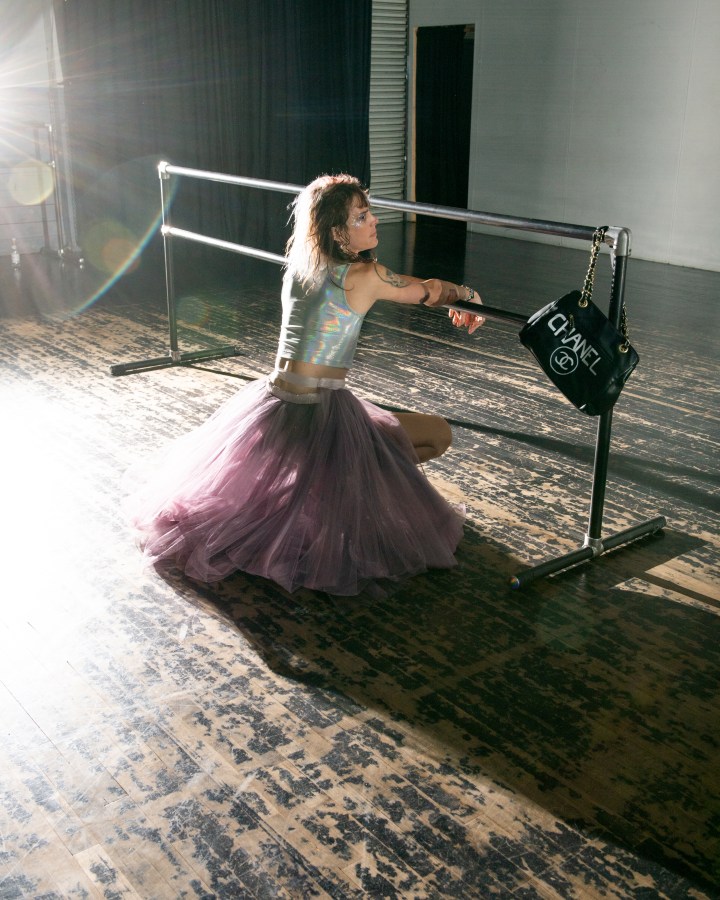
As to what the naming or framing of what my gender might be if we existed in a world without our current classification of it, I know not. Without the words or even a concept of gender as we have fashioned it I certainly wouldn’t presume to claim knowledge of how I would act or construct a similar facet of identity. I believe we all have innate qualities that demonstrate as thoughts and behaviors and reactions, endocrinological and biologically informed, but if we didn’t create the idea of “femme” or the idea of “girl” then I have no idea how I would exist outside of the vacuum. In the same way I wonder if I would experience dysphoria if we had never constructed cisheteronormative society. My assumption is that this is a symptom of a culture that demonizes, erases, denigrates, and murders trans people.
Part of where my comfort is derived from in reflecting on personal femme centered hxstory is how I can explain the self-awareness of knowing I was trans, without having the language for it. It is the closest experience I have to what described earlier, this conceptual world predating gender and or existing beyond the binary. No person is more authentic or more valid in their transness or non-binary existence because they were able to identify it at an early age. But when so much of this world moves to extinguish trans existence and invalidate our lives, I do sometimes find solace in this self-awareness that predates having a word or concept to describe it. It is an understanding without words or articulated concepts. It feels magical. And profound.
It is important to acknowledge though, when I look at these external points with which I discovered how to express and articulate my gender in an affirming way, beyond the sacred internal, the indescribable knowing, with an amount of critical inspection I often find these external mapping points informed by the violent and harmful gender binary we exist in. And it definitely sours the sweetness. “Girls Just Wanna Have Fun” is an incredible song but the concept of “girl” is a racist illusion and one that does a great deal of harm in its boundaries and their violent enforcement.
To my trans girl, trans woman, trans femme, and non-binary femme siblings… I wish you all of an abundance of gender joy. I wish you all the affirmations you can find. May they be in pop songs and in eye shadow palettes. May they be in thick beards and chest hair. May they be in reflection and seeing oneself in the parts of others. May they already be inside of you. I wish and make plans for all of us to transform and transmute this world into something far more expansive and liberatory. Dancing until the makeup is running down our faces. In a world where make-up is for whoever the fuck wants it.
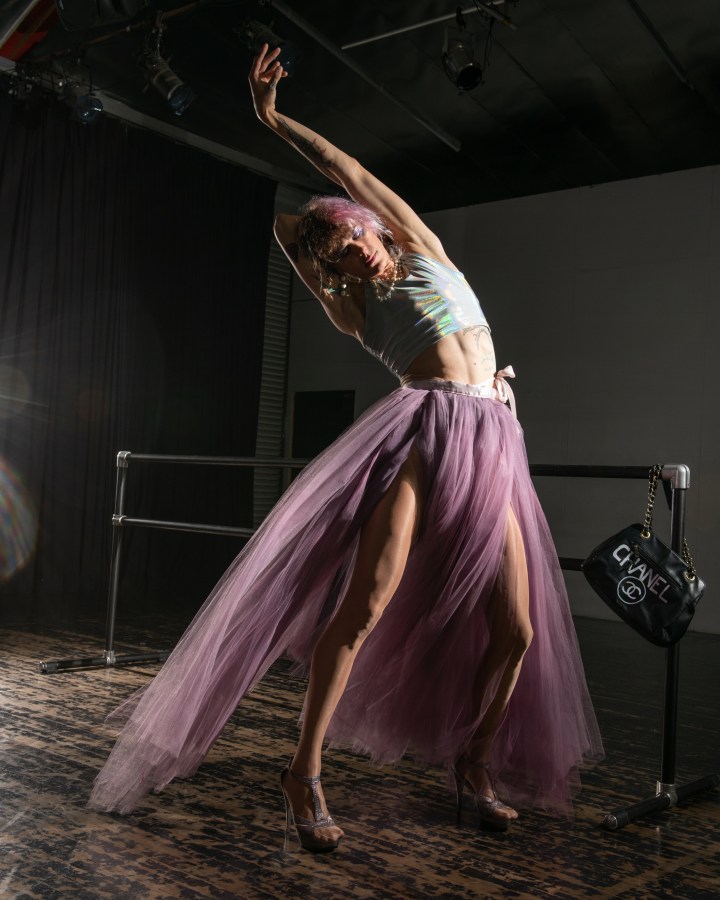
Photographer and Art Director: Janelle Pietrzak // @janellepietrzakphoto
Makeup Artist: Kendall Bennewitz // @Kendall.Bennewitz
Hair: Stephanie Craig // @stephaniecraig_hair
Top: Jessica Owen // @jessicaowenarts
Skirt: Zzyzx Couture // @zzyzx_Coutur
Special thanks to Sevi Giovanni Xcetera for advance edits



Thanks for this, I appreciate your thoughts, I have found it kind of infuriating to wonder “who would I be without all this”…, culture, enforced gender norms, etc.? what does authenticity to oneself even mean? Because there’s just no satisfying answer. This also makes me think about Julia Serano’s Whipping Girl, and the idea that femininity often gets cast as artificial and decorative.
I have fallen in love with these words. I’ve never wanted a personal essay tattooed on my body before. Thank you, CJ Kitten.
This article takes us on a journey and weaves us in and out of the private and public in both honestly personal, and also historic ways— I am in awe at the radical emotionality, the ability (of the author) to bring us into her room, and back through time. So poetic and precise — and vulnerable throughout. The type of writing we need more of.
absolutely love this
I love all of this so much. Such an intelligent and thought-provoking article. Thank you for sharing your insight and personal experience. As a non-binary AFAB who is currently allowing myself to present more masc after 40 years of trying to be femme (and still enjoying, maybe even missing some of it), I’m grateful for the blurry lines of gender expression and discussions of it. There’s so much freedom available for the taking. I hope more of the cis-world grabs hold of it as we are.
I love this so much!!
Lately, I have been thinking a lot about these sort of ideas. Finding and reading this today has been a very happy coincidence. I love this sort of in-depth personal reflection. Thank you!
This essay takes us on a trip, weaving us in and out of the private and public in both honestly personal and historically significant ways— I am in awe of the author’s tremendous emotionality, her ability to transport us inside her room and back in time. So lyrical and accurate — yet vulnerable all the way through. This is the kind of writing we need more of.
https://waffle-game.com